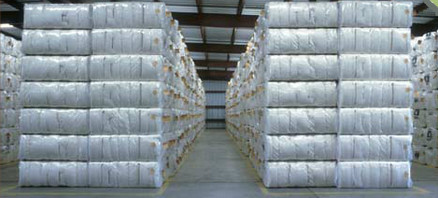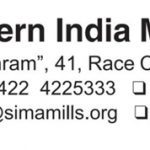Coastal Cargo Movement of Raw Cotton to Increase by 266 per cent
The coastal cargo movement of raw cotton from Gujarat to Tamil Nadu in containers is expected to increase by 266 % in 2014-15. It would increase from 1200 containers in 2013-14 to 4400 containers in 2014-15.
Earlier, the Ministry of Shipping facilitated the meeting of stakeholders, South Indian Mills Association (SIMA) and the Indian National Shipowners Association (INSA) which resulted in INSA offering freight rates which would reduce the cost of transportation up to 30%. The INSA members would also receive additional cargo support in coastal shipping.
SIMA had requested Ministry of Shipping that foreign flag vessels should be allowed to transport raw cotton from the west coast of India to the southern coast as it was hoped that they would charge lower freight rates compared to Indian shipping lines. It is estimated that around one million tonnes of cotton moving from Gujarat/ Maharashtra to mills in Tamil Nadu would be carried by road. Director General (Shipping) had held consultations with SIMA and INSA with a view to increase transportation of raw cotton by coastal shipping. The Indian flag vessels owners had conveyed that they could make approximately 7,500 Forty Feet containers (TEUs) available per month, which was sufficient to carry raw cotton.
Tamil Nadu’s Case for Relaxing Cabotage Rule to Transport Cotton
Tamil Nadu produces only 500,000-600,000 bales of cotton per year against its annual requirement of 12.0 million bales, while Gujarat, which has 2.75 million spindles, consumes only around 1.5 million bales a year out of its annual production of over 10.0 million bales. To fill the gap in supply and demand, Tamil Nadu mills procure over 10.0 million bales of cotton from other states, especially from Gujarat and Maharashtra.
Tamil Nadu accounts for one-third of the textile business in the country and the textile mills in the state account for 44 per cent of the total spinning capacity of the country and 60 per cent of its yarn exports and altogether the mills earn the country a total foreign exchange of over Rs. 75,000 crores.
The Tamil Nadu textile industry provides direct employment for over 5.0 million people and is alongside livelihood of several million cotton farmers, powerloom, handloom and garment sector workers, while the textile hub of Tirupur accounts for 70 per cent of total cotton knitted garments produced in India.
The foreign shipping lines did not show much enthusiasm in quoting freight. Subsequently some companies did quote rates, but these were higher than that of Indian companies. Subsequently, INSA offered attractive freight rates and assured adequate deployment of vessels to cater to the demands of SIMA as cotton shifted from road to coastal shipping.
This modal shift is beneficial to both SIMA and INSA. Textile industry will benefit from lower transport costs and Indian shipping industry will benefit from greater business opportunities, while the country will benefit by way of reduced fuel consumption and green economy.
SIMA has been urging the Union Government to relax Cabotage rule and permit foreign flag vessels to transport cotton from ports in Gujarat to either Tuticorin or Cochin ports, so that the freight charge could be decreased by 50 per cent of the existing cost.
According to SIMA, due to steep increase in lorry freight, transportation of cotton by road had become unviable as the current lorry freight fare for transporting cotton from Gujarat to Tamil Nadu is Rs 865 per bale of 170 kgs each. On the other hand, Indian shipping vessels charge Rs 672 per bale for transporting cotton from Gujarat to Tamil Nadu which is higher than the fare of Rs. 433 per bale for transporting cotton from West Africa to Tamil Nadu. According to SIMA, the mills are spending Rs 85,000 to transport 100 bales by lorry from Gujarat to Tamil Nadu, whereas, China is able to transport 150 bales of cotton from Gujarat to Shanghai at $100-$350 using empty cargo vessels returning in the same route.
To solve this long pending issue, the director-general of shipping convened the first stakeholders meeting on December 11, 2014 wherein Indian National Shipowners’ Association (INSA), SIMA, CITI, TEXPROCIL, Cotton Association of India (CAI) and the Textile Commissioner participated.
At this meeting, it was decided to have mutual discussions between SIMA and INSA to come to an understanding to make domestic coastal shipping cost effective, as relaxation of Cabotage Rule would affect the Indian shipping industry.
Cabotage Rule?
The cabotage law makes it mandatory to use Indian ships for transporting cargo between different ports along the country’s coast. Foreign ships can be allowed to operate only when Indian ships are not available after taking a licence from India’s maritime regulator, according to the cabotage law.
The government is considering to grant relaxation as an effective trade strategy to minimize, if not totally eliminate, India’s dependence on neighbouring hub ports, Colombo for instance, to send and receive transshipment containers which will prove cost effective to exporters and importers. With this goal, the govt is likely to grant cabotage relaxation for some ports which include Mundra, Pipavav, Vizhinjam and Vizag.
Following this meeting, further meetings between SIMA and INSA representatives revealed that Indian shippers have to pay duty on bunkers consumed and other taxes which are not applicable on a foreign shipping company and other issues which were the root causes for higher rates charged by Indian shippers. A joint memorandum was sent to the Ministry of Shipping and also to Ministry of Textiles in February seeking certain concessions and relaxations in the forthcoming budget for the Indian shippers so as to bring down the cost of cotton transport on par with foreign shippers.
The joint memorandum also appealed to the Ministry’s to provide duty free bunkers for Indian flag vessels for carrying cotton and textile products on Indian coasts and also resolve issues pertaining to restriction of number of moves in the ports.
For the last four years, SIMA has been urging the Union Government directly and also through Confederation of Indian Textile Industry (CITI) and Cotton Textiles Export Promotion Council (TEXPROCIL) to relax Cabotage rule and permit foreign flag vessels to transport cotton. It is expected that INSA’s offer of lower freight rates and assurance of deployment of more vessels to fully cater to the demand for cotton transportation from SIMA members and other cotton buyers.

Raw Coton Bales from Madhav Cotton Industries, manufacture and exporter, located at Veraval (Shapar) dist. Rajkot, Gujarat. India. They have fully automatic ginning and pressing unit. E-mail : [email protected]
It is estimated that around 1mn tonnes of cotton is moved from Gujarat & Maharashtra to textile mills in Tamil Nadu by road. “Textile industry is expected to get a big boost in profits from lower transport costs and the Indian shipping industry will benefit from greater business opportunities, while the country will benefit by way of reduced fuel consumption.





